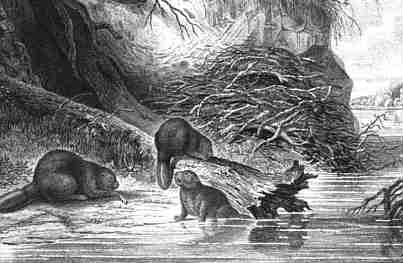An die Zürcherische Jugend auf das Jahr
1842, XLIV. Stück ; 12S., 1 Litho
Der Biber
H.R. Schinz
Die zoologische Sammlung (Fortsetzung) Link
zum Autor und der inzwischen
stark gewachsenen, modernen Sammlung
 |
Nordamerikanische Biber, fec. Karl Bodmer
Aus dem Reisewerk des Prinzen von Wied, Vignette zum 17. Kapitel.
aus dem Inhalt:
"Es gibt falbe, olivenbraun überlaufene, ganz schwarze, ganz weisse
und gefleckte Biber. Die Länge eines recht grossen Bibers ist von
der Spitze der Schnauze bis zur Schwanzwurzel 2.5 Fuss, der Schwanz 1 Fuss
lang und über 4 Zoll breit. Das Gewicht 50 bis 60 Pfund.
Der Biber war ehemals fast in ganz Europa anzutreffen, und auch in
unseren Vaterlande; allein bei uns ist jede Spur des Tieres verschwunden.
Dagegen wurde erst noch im vorigen Jahr ein Biber in der Rhone, in Frankreich
gefangen. ..."
In der Schweiz gab es im sechzehnten Jahrhundert noch viele Biber .
In England seien diese 1188 ausgerottet worden. |
Das Neujahrsblatt behandelt die Nagetiere (inkl. dem Inhalt des Schaukastens
der zoologischen Sammlung). Davon wird der Biber herausgegriffen.
Insbesondere wird der folgende Text zum Märchen erklärt und
durch eine authentische Schilderung ersetzt.
Noch in C. Ph. Funke 1790 konnte man lesen: Die Biber werden unterteilt
in den einsamen (Gruben- oder Erd-) Biber und den gesellschaftlichen Biber.
In Deutschland gibt es nur noch Erdbiber mit abgeschabtem Pelz. Die Gesellschaftsbiber
machen alles gemeinsam. Der Damm wird gebaut, indem Bäume gefällt,
behauen und geflösst werden. ...Der Schwanz wird als Maurerkelle
zum verfugen von Lücken im Damm mit Lehm benutzt. ... Nach dem Dammbau
beginnt die Konstruktion der Häuser. Jedes ruhet auf sechs Pfählen,
die sie am Ufer des Flusses, jedoch im Wasser fest einschlagen. Sodann
führen sie zwei Fuss dicke Wände von künstlich durchflochtenen
Zweigen, die mit Lehm, Schlamm und Moos ausgefüllt werden, auf, so
fest, dass weder Luft noch Wasser eindringen kann. ... Sie haben gemeiniglich
drei Stockwerke, wovon das unterste unter Wasser steht. Das Dach ist gewölbt
und die ganze Hütte eiförmig. Sie lassen auch mehrenteils zwei
Zugänge zu jeder Wohnung, einen von der Land- und den anderen von
der Wasserseite. Alles ist inwendig glatt und reinlich und der Fussboden
mit Moos geschmückt. Die Biber sitzen paarweise, Männchen und
Weibchen zusammen, aber so, dass der Schwanz immer im Wasser hängt.
Solche Wohnungen stehen zehn bis zwölf auch wohl 20 bis 25 in einer
Reihe nebeneinander. ...
Home Liste der Neujahrsblätter
To the Zurich's youth on the year 1842, XLIV. Piece; 12 pg., 1 Litho
The beaver by H.R. Schinz
Real title: The zoological collection (continuation)
The leaflet treats the rodents were the beaver was selected.
Picture: North American beavers, fec. Karl Bodmer, picture from the travel work of the prince von Wied,
vignette to 17th. Chapter.
Citation:
"There are sandy colored, olive-brown, completely black, completely white and spotted beavers. The length
of a handsome beaver from tip of snout to root of tail is 2.5 feet. The tail is 1 foot long and 4 inches wide.
They weight 50 to 60 lb. The beaver was to be found formerly nearly in all Europe, and also in our country;
however here each trace of the animal disappeared. On the other hand a beaver was trapped in the Rhone, in France
in the year 1841. In Switzerland there were many beavers still in the sixteenth century. In England they are said
to be exterminated in 1188.
In particular the following text is declared as a fairy tale and replaced by an authentic description.
Still in C. Ph. Funke 1790 (Treatise on natural history for teachers use) is printed: The beavers are divided
into the lonely (pit- or ground-) beaver and the social beaver. In Germany only earth beaver with scraped off fur
are left. The society beavers are doing everything together. The construction of a new dam is planed carefully. The
first thing is piling up some loam. Then the group is cutting trees, hewing them and rafting the boles, and rammed
vertically for the dam. ... The tail is used as trowel for filling gaps in the dam with loam... After the construction
of embankment the construction of the houses begins. Everyone rests on six poles, which are forced firmly into the
bank of the river. The walls of the house are two feet thick and of artificially woven branches, which are filled
out with loam, mud and moss, so firmly that neither air nor water can penetrate... The houses have usually three
floors, where the basement is under water. The roof is curved and the whole hut egg-shaped. There are two entrances
to each dwelling, one of the land and the other is from the water side. Everything within is smooth and immaculately
and the floor decorated with moss. The beavers sit in pairs, males and females together, but so that the tail always
hangs in the water. (Showing that they are water animals). Such dwellings are built in a row of ten to twelve also
some line ups of 20 to 25 exist. ...
